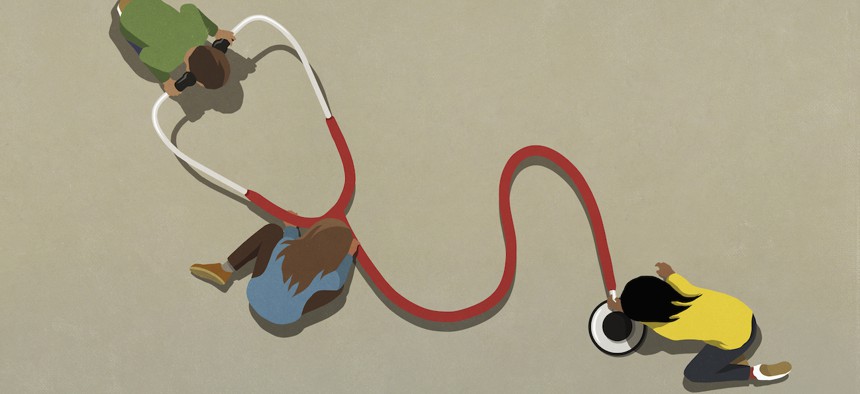
The new health benefit program came after years of congressional bickering. Malte Mueller/Getty Images
Postal Union Expects a ‘Smooth Transition,’ But Notes Possible Bumps In the Road for the New Health Benefit Program
Employees, retirees and family members are expected to shift to the Postal Service Health Benefits Plan by Jan. 1, 2025.
More than a decade in the works, the new health care insurance program enacted last year for the approximately 600,000 Postal Service employees—the Postal Service Health Benefits Plan—is slowly inching toward reality. Though not scheduled to come into effect even partially until next year, postal unions and the Office of Personnel Management are already working to clarify its design, and the changes in store for postal employees.
The new plan came after years of congressional bickering over how to staunch years of annual red ink on the Postal Service’s books, as the massive organization was forced by law to separately pre-fund the health care costs of future retirees.
“We want to be clear that we, at the American Postal Workers Union, are supportive of the changes to postal health insurance that are coming with the Postal Service Reform Act passed in 2022,” Mark Dimondstein, president of the union told Government Executive. “Our concerns were cleared up in the legislation itself—most importantly, we were able to make sure that all postal employees will actually be covered under the same structure as the Federal Employees Health Benefits Plan, even if they would come under a new and separate insurance pool.”
“We did get that assurance. The law is crystal clear that these new plans are still under FEHB, and administered by OPM,” he said. “Again, the difference is in the name, and that our workers simply will come under a separate pool within FEHB.”
APWU, and other postal unions such as the National Association of Letter Carriers, have posts on their websites about the upcoming changes—drawing attention to a recent OPM FAQ page about the program. Rather than USPS enrolling employees into the health plans, as occurs at other agencies, here OPM will do the heavy lifting.
“We expect a smooth transition,” Dimondstein said. “And actually we expect the vast majority of our people will come under the same plans—or very, very similar ones—to the ones they are in now.”
Any major hitches, so far, for postal employees? “Where we hear the angst at the moment from our community is among postal retirees,” Dimonstein said. “But we want them to know that if a retiree has to date not chosen to get Medicare Part B, they do not have to get Medicare Part B right away. In other words, they don’t have to join Part B to keep their current healthcare plans. To transition to PHSB they can join Medicare Part B later, with any penalties being waived— because normally as many people know there’s a penalty added for each year after age 65 for not joining, but that is waived for our people.”
The FAQ about the upcoming transition to PSHB backs Dimonstein’s words: “Most Postal Service annuitants and their eligible family members who are entitled to Medicare Part A will be eligible to enroll in Medicare Part B during a six-month special enrollment period (SEP),” it states.
If the new program is implemented as planned, those who qualify for the SEP will be notified “prior to April 1, 2024” under the terms of the Postal Service Reform Act.
“All these details are something we really have to educate people on in the coming months,” Dimondstein said. “We want our retirees also to feel comfortable with the program. All postal unions are working with the Postal Service to make sure that everybody knows what dates things fall into place, when Open Season is, and when people have to make their choices, and so on.”
“We got what we thought was needed,” Dimondstein told Government Executive. “What this change does in the long run is provide savings to the Postal Service. Why? Because Medicare Part B becomes primary for our retirees—and that’s less pressure on FEHB and its plans.”
“But, also over time, the new program should save money for our members too, for the same reason,” Dimondstein said. “The premiums for our PSHB plans, as the program matures, should be lower than those for other feds under FEHB. The difference being that our future postal retirees will have to pay for Medicare Part B reducing the PSHB program’s costs, compared with other feds under FEHB who won’t have to.”
Information on the new program will be coming down the pike over the coming months, Dimondstein noted, with Open Season of fall 2024 bringing the first real steps for postal employees.
It should be noted that postal unions’ welcoming and advance work on PSHB comes at a time when those same organizations are struggling against other changes in their pay and benefits. Particularly tough have been reduced hours and pay cuts for rural letter carriers.
PSHB is scheduled to have its plans come into effect on Jan. 1, 2025.






